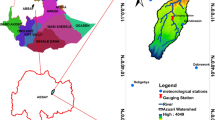Abstract
In this study, morphometric analysis and prioritization of the eight miniwatersheds of Mohr watershed, located between Bayad taluka of Sabarkantha district and Kapadwanj taluka of Kheda district in Gujarat State, India is carried out using Remote Sensing and GIS techniques. The morphometric parameters considered for analysis are stream length, bifurcation ratio, drainage density, stream frequency, texture ratio, form factor, circularity ratio, elongation ratio and compactness ratio. The Mohr watershed has a dendritic drainage pattern. The highest bifurcation ratio among all the miniwatersheds is 9.5 which indicates a strong structural control on the drainage. The maximum value of circularity ratio is 0.1197 for the miniwatershed 5F2B5b3. The miniwatershed 5F2B5a2 has the maximum elongation ratio (0.66). The form factor values are in range of 0.29 to 0.34 which indicates that the Mohr watershed has moderately high peak flow for shorter duration. The compound parameter values are calculated and prioritization rating of eight miniwatersheds in Mohr watershed is carried out. The miniwatershed with the lowest compound parameter value is given the highest priority. The miniwatershed 5F2B5b2 has a minimum compound parameter value of 3.12 is likely to be subjected to maximum soil erosion hence it should be provided with immediate soil conservation measures.
Similar content being viewed by others
References
Biswas, S., Sudharakar, S. and Desai, V.R. (1999). Prioritization of subwatersheds based on morphometric analysis of drainage basin: A Remote Sensing and GIS approach.Journal of Indian Society of Remote Sensing,27(3): 155–166.
Chopra, R., Dhiman, R. and Sharma, P.K., (2005). Morphometric analysis of sub-watersheds in Gurdaspur District, Punjab using Remote Sensing and GIS techniques.Journal of the Indian Society of Remote Sensing,33(4): 531–539.
Desmet, P. and Govers, G. (1996). A GIS procedure for automatically calculating the USLE LS factor on topographically complex landscape units.Journal of Soil and Water Conservation,15(5): 427–433.
Horton, R.E. (1945). Erosional development of streams and their drainage basins: hydrophysical approach to quantitative morphology.Bulletin of the Geological Society of America,56: 275–370.
Jasrotia, A.S., Dhiman, S.D. and Agrawwal, S.P. (2002). Rainfall runoff and soil erosion modeling using remote sensing and GIS techniques -a case study of Tons watershed.Journal of the Indian Society of Remote Sensing.30(3): 167–180.
Khan, M.A., Gupta, V.P. and Moharana, P.C. (2001). Watershed prioritization using remote sensing and geographical information system: a case study from Guhiya. India.Journal of Arid Environments,49: 465–475.
Kothyari, U.C. and Jain, S.K. (1997) Sediment yield estimation using GIS.Hydrol. Sci. J., IAHS,42(6): 833–843.
Miller, V.C. (1953). A quantitative geomorphic study of drainage basin characteristics in the Clinch Mountain area. Virginia and Tennessee. Proj. NR 389-402, Tech. Rep 3, Columbia University, Department of Geology, ONR, New York.
Nookaratnam, K., Srivastava, Y.K., Venkateswarao, V., Amminedu, E. and Murthy. K.S.R. (2005). Check dam positioning by prioritization of micro- watersheds using SYI model and Morphometric analysis - Remote sensing and GIS perspective.Journal of the Indian Society of Remote Sensing,33(1): 25–38.
Schumn, S.A. (1956). Evolution of drainage systems and slopes in badlands at Perth Amboy, New Jersey.Geol. Soc. Am. Bull.,67: 597–646.
Shrimali, S.S., Aggarwal, S.P. and Samra, J.S. (2001). Prioritizing erosion-prone areas in hills using remote sensing and GIS - a case study of the Sukhna Lake catchment, Northern India.JAG,3(1): 54–60.
Srinivasa, V.S., Govindaonah, S. and Home Gowda, H. (2004). Morphometric analysis of sub-watersheds in the Pawagada area of Tumkur district South India using remote sensing and GIS techniques.Journal of the Indian Society of Remote Sensing,32(4): 351–362.
Strahler, A.N. (1964). Quantitative geomorphology of drainage basins and channel networks, section 4-II. In: Handbook of Applied Hydrology, edited by V.T. Chow. McGraw-Hill, 4–39.
Thakkar, A.K. (2006). Morphometric analysis and prioritization of miniwatersheds using Remote Sensing and GIS Techniques, M.E. Dissertation (Water Resources Management), Dept. of Civil Engrg., L.D. College of Engineering, Ahmedabad, Gujarat, India.
Author information
Authors and Affiliations
Corresponding author
About this article
Cite this article
Thakkar, A.K., Dhiman, S.D. Morphometric analysis and prioritization of miniwatersheds in Mohr watershed, Gujarat using remote sensing and GIS techniques. J Indian Soc Remote Sens 35, 313–321 (2007). https://doi.org/10.1007/BF02990787
Received:
Revised:
Issue Date:
DOI: https://doi.org/10.1007/BF02990787




